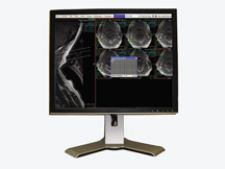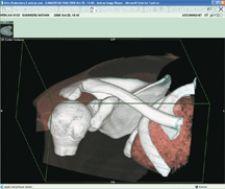
Amicas Radstream solution employs an acuity algorithm with a color-coding scheme to prioritize exams.
When reading through a large set of image data, the last thing a radiologist wants is interruptions. Because efficient workflow is critical to productivity one of the principle complaints among radiologists is how to limit interruptions. Although some interruptions may be warranted, such as a STAT case alert or a call from a referring physician, interruptions need to be managed.
PACS/RIS Manage Interruptions
Most PACS and PACS/RIS solutions have incorporated basic tools to limit the number of interruptions. This includes the ability to prioritize studies based on the case or patient description and emergent case alerts.
An automatic polling system in Agfa�s IMPAX determines if new exams that match the criteria of the worklist have arrived at the server. Exams classified as STAT are automatically moved to the top of the worklist so that they are the next reported study. The solution also allows the user to set aside a study with all parameters preserved, such as window level, layout and location of series. When the physician logs back in, they are presented with the study exactly as it was left. IMPAX can also recall studies that have been reviewed and dictated from a history list, facilitating study recall for referring physicians or other clinicians.
The syngo Suite of integrated RIS/PACS from Siemens Medical Solutions has the ability to warn the radiologist of a STAT case. The radiologist can then open this case on top of the existing cases without affecting it in any manner, and read, dictate, close and deliver the STAT report to the ER.
Memory Boost Opens More Options
One approach to reducing interruptions is to boost the available memory. With its Linux-based platform, Workstation BRIT Vision provides 16 GB of memory on the workstation to manage memory, which allows multiple patient files to remain open in the viewer under different tabs. �The patient file is exactly as it was left, same format, same worklist,� said Shelly Fisher, president, BRIT Systems. �With BRIT View, the patient list is always just a click away and it can be pulled up on any monitor.� For acuity levels, BRIT has implemented �categories� of exams that can be preset based on information that appears in the order, or by clerk or technologist. Radiologists can sort the studies based on this criteria and BRIT can produce reports showing the time from when the exam was stored until it was read based on the categories.
Merge Healthcare has recently improved upon its RIS/PACS solutions by expanding upon its �interrupt session� feature. Until recently, Merge�s customers were limited to two interrupt sessions, and when more than two exceeded system memory resources, the system would slow or even stop. With native 64-bit processing now offered in its PACS and RIS/PACS solutions, Merge Healthcare makes four interrupt sessions available to its customers � without unduly burdening the system.
A freeze mechanism, introduced by Carestream Health, operates as an interrupt feature that lets the radiologist freeze an open study anytime they are interrupted. Once the interruption is over, the radiologist simply hits the button again and they can resume reading exactly where they left off.
With NovaRad�s NovaRIS and NovaPACS, both allow the user to select a new viewer when interrupted, leaving the existing case untouched and waiting for review.
Acuity Algorithm
A unique approach to radiology interruptions leverages advanced computer analytics. Amicas recently developed an acuity algorithm for workflow interruptions in conjunction with Mark Halsted, M.D., chief, informatics research core and associate professor, department of Radiology, Cincinnati Children�s Hospital Medical Center and Craig Froehle, Ph.D, consultant, University of Cincinnati College of Business, department of Quantitative Analysis and Operations Management (QAOM).
�The difficulty has been that you couldn�t tell which cases you should read next,� said Dr. Halsted. �If you have a stack of STAT requisitions, there is no way to know if the first one is the most important or the 30th one is because STAT is an overused term.�
The team developed an algorithm that �takes into account the mental heuristics through which radiologists make decisions about triaging cases,� Dr. Halsted explained. By looking at the response of a large number of independent variables by a large group of radiologists, Dr. Halsted and Froehle were able to identify the key elements that a radiologist uses when prioritizing cases. Those elements were then included in the algorithm and tested against the radiologists who were most inconsistent with themselves and across the group.
�We determined that interruptions could be pre-empted by prioritizing the cases most likely to generate an interruption, reading those first, and employing human operators to contact the clinician as soon as the results were available.,� said Dr. Halsted. �This not only improved patient care but also reduced the likelihood that the clinician is going to call looking for a result. And if the clinician has a follow-up question, RadStream PACS provides the operator with their location, phone number and pager, so the operator connects the clinician to the radiologist. This facilitates communication, while eliminating tedium.�
Included in the acuity algorithm is a color-coding scheme that includes medical factors, such as patient acuity level and how long that patient has been waiting. The algorithm also considers the type of study ordered, the age of the patient, the procedure as well as other factors.
�We found a 38 percent reduction in department-wide outpatient median turnaround time. Then, we combined our worklists even further based on queuing theory � the more you share the worklists, the more you reduce your turnaround, and we reduced it another 29 percent,� said Dr. Halsted. Amicas is incorporating the acuity algorithm into its PACS, RadStream.
Setting Priorities Gets Personal
As technology allows users to become more interactive, a simple color-coding protocol for setting priorities can have a significant impact on a radiologist�s workflow. IntelePACS by Intelerad supports multiple priority levels with color coding that is accessed on the PACS. �A radiologist can escalate the status of the case, allowing them to adapt to immediate needs and to concentrate on the cases that are most important,� explained Delia So, marketing and business solutions manager, Intelerad. On a system level, a thorough RIS integration is also important for case prioritization and enhanced functionality.
Interruption tools in some cases are equally important for both radiologists and referring physicians. �Our worklist can be personalized and group studies based on a combination of sites, study descriptions, series descriptions and levels of acuity, which can be fed from the HIS/RIS or entered manually,� said Allen Scales, vice president, Corporate Strategy, Emageon. �Our personal content management solution optimizes reading for remote radiologists, allowing them to subscribe to folders of interest, stream studies on their worklist in the background while reading, and utilize the full suite of visualization tools, including study sign-off remotely.�
My Toolkit
What if a you could customize your own toolkit? Philips Medical Systems encourages tool customization with an open programming interface for users to add specific applications or productivity tools to iSite PACS, developing tools that are most useful to the individual�s environment. �We encourage our customers to develop or acquire custom tools,� said Isam Habboush, director of Product Marketing, Philips Medical Systems.
A suite of custom tools for iSite developed by Primordial embeds directly into the PACS user interface. Several components of the RadConnect suite include RadMail and RadConfer. �RadMail resides within the PACS to automatically link messages to the study that is open on the radiologist�s workstation,� explained Dimitri Zarboulas, principal. �RadConfer allows the technologist to push messages to the radiologist with a link to the exam. The radiologist controls when they respond,� further limiting any interruption.
As radiologists take greater control over the design of their workflow and implement strategies to reduce and manage interruptions, some experts believe that radiologists could read up to one-third more exams, plus, turn around reports with greater job satisfaction.


